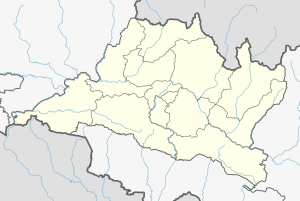Kulekhani dam
| Kulekhani dam | ||
|---|---|---|
| The reservoir with the dam in the background | ||
| location | ||
|
|
||
| Coordinates | 27 ° 35 '26 " N , 85 ° 9' 21" E | |
| country |
|
|
| place | Makwanpur District , Narayani Administrative Zone | |
| Waters | Kulekhani | |
| power plant | ||
| owner | Nepal Electricity Authority (NEA) | |
| operator | NEA | |
| technology | ||
| Bottleneck performance | I: 60 MW II: 32 MW III: 14 megawatts |
|
| Standard work capacity | I: 211 million kWh / year II: 104.6 million kWh / year |
|
| Turbines | I: 2 Pelton turbines | |
| Others | ||
The Kulekhani dam is located in the Makwanpur district , Narayani administrative zone , Nepal and dams the Kulekhani . The city of Hetauda is located approx. 25 km south-west, the capital Kathmandu approx. 15 km north-east of the dam.
Construction work began in 1977. The Kulekhani I power plant was commissioned in 1982. The dam was built by the Nepal Electricity Authority (NEA) and is also operated by NEA. It is used to generate electricity.
Barrier structure
The barrier structure is a stone embankment dam with a height of 107 (or 114 or 147) m. The top of the dam is at an altitude of 1,534 m above sea level . The length of the dam crest is 420 (or 397) m. The volume of the structure is 3.5 and 4.416 million m³.
The flood relief is on the left side of the dam. At least 1,300 m³ / s can be discharged through them.
The dam was only slightly damaged in the earthquakes in April and May 2015, according to the Ministry of Energy . According to International Rivers , several cracks can be seen on the dam crest, but they have been repaired. Based on the recommendation of a Japanese team of experts, NEA will only dam the reservoir up to a storage destination of 1,525 m.
Reservoir
With the normal storage target of 1,530 m, the Indra Sarobar reservoir extends over an area of around 2.2 km² and holds 85.3 (or 73.6) million m³ of water - of which 73.3 million m³ can be used to generate electricity . The minimum storage target is 1,476 m. The reservoir has a length of 7 km. It is also used for fish farming.
Kulekhani I power plant
The Kulekhani I power plant has an installed capacity of 60 MW . The average annual production is 211 million kWh .
The two machines in the power plant went into operation in May 1982. You are in an underground machine house. The Pelton turbines have a maximum output of 30.6 MW each and the generators 35 MVA . The nominal speed of the turbines is 600 / min. The nominal voltage of the generators is 11 kV . In the switchgear , the generator voltage is increased from 11 kV to 66 kV using power transformers.
The height of fall is 550 m. The maximum flow rate is 6.55 m³ / s per turbine. A tunnel (length 5.8 km, diameter 2.5 m) leads from the dam to the power plant.
Kulekhani II power plant
The Kulekhani II power plant has an installed capacity of 32 MW . The average annual production is 104.6 million kWh . The two machines have a maximum output of 16 MW each. They went into operation in November 1986. The fall height is 284 m. The maximum flow rate is 13.3 m³ / s.
Kulekhani III power plant
The Kulekhani III power plant is still under construction. It will have an installed capacity of 14 MW .
Others
The construction costs for the dam and the Kulekhani I power plant were almost USD 118 million .
See also
Individual evidence
- ↑ a b c d Annual Report 2014. (PDF 10.3 MB, pp. 12, 18, 24) (No longer available online.) Nepal Electricity Authority (NEA), archived from the original on March 5, 2016 ; accessed on October 13, 2015 .
- ↑ a b c d e f g h i j k l m Nepal Appraisal of the Kulekhani Hydroelectric Project Report No. 833a-NEP. (PDF 3.35 MB, pp. 16 (8), 20 (12), 36–40 (Annex 8)) World Bank , November 25, 1975, accessed on October 13, 2015 .
- ↑ a b c d e Kulekhani-I Hydroelectric Power Plant Nepal. Global Energy Observatory, accessed October 13, 2015 .
- ↑ a b c Kulekhani Dam. structurae.de, accessed on October 13, 2015 .
- ↑ Japanese team to assess Kulekhani. kathmandupost.ekantipur.com, May 24, 2015, accessed on October 13, 2015 .
- ↑ Nepal Earthquake Tests Dam Safety. www.internationalrivers.org, accessed on October 13, 2015 (English).
- ↑ a b NEA not to let Kulekhani reservoir fill up completely. kathmandupost.ekantipur.com, August 10, 2015, accessed on October 13, 2015 .
- ^ A b Prospects of fisheries enhancement and aquaculture in lakes and reservoirs of Nepal. (by MK Shrestha, RK Batajoo and GB Karki). FAO , accessed October 13, 2015 .
- ^ Kulekhani Hydroelectric Power Station. www.sustainablehydropower.org, accessed on October 13, 2015 .
- ^ Kulekhani-II Hydroelectric Power Plant Nepal. Global Energy Observatory, accessed October 13, 2015 .

